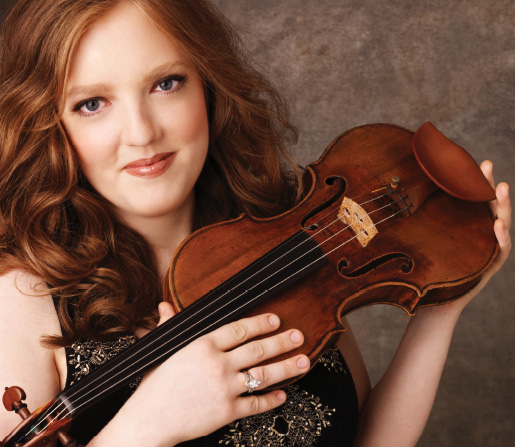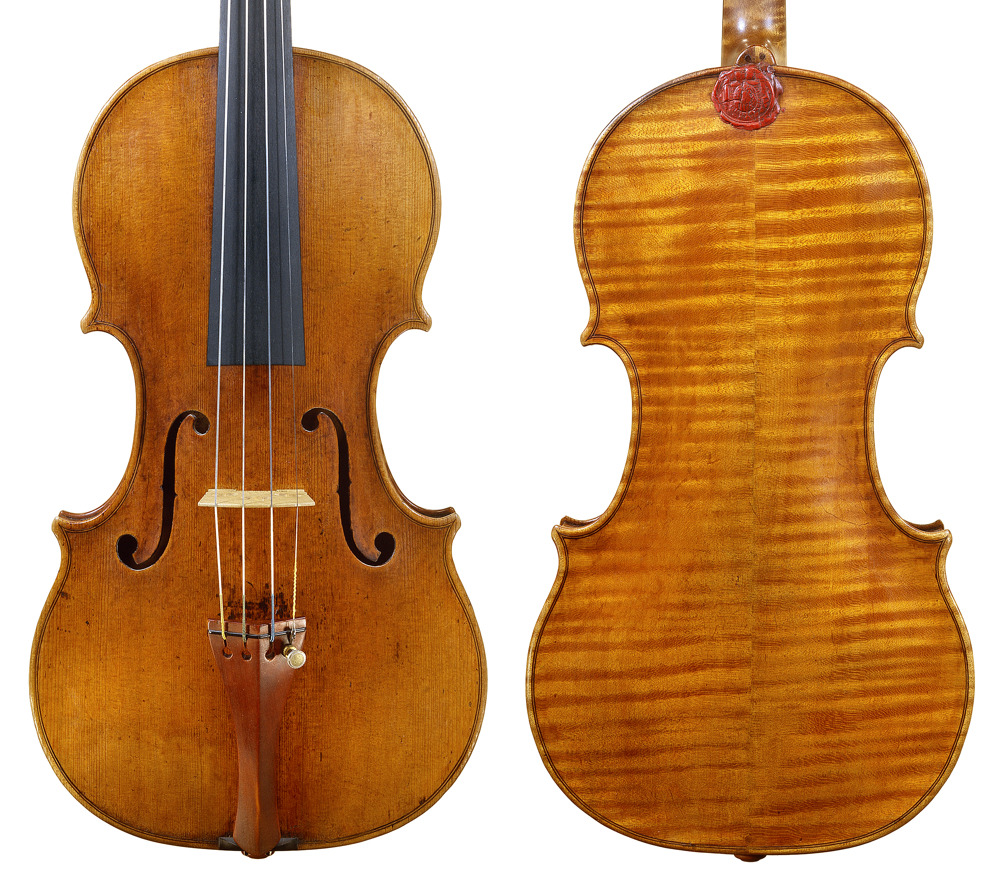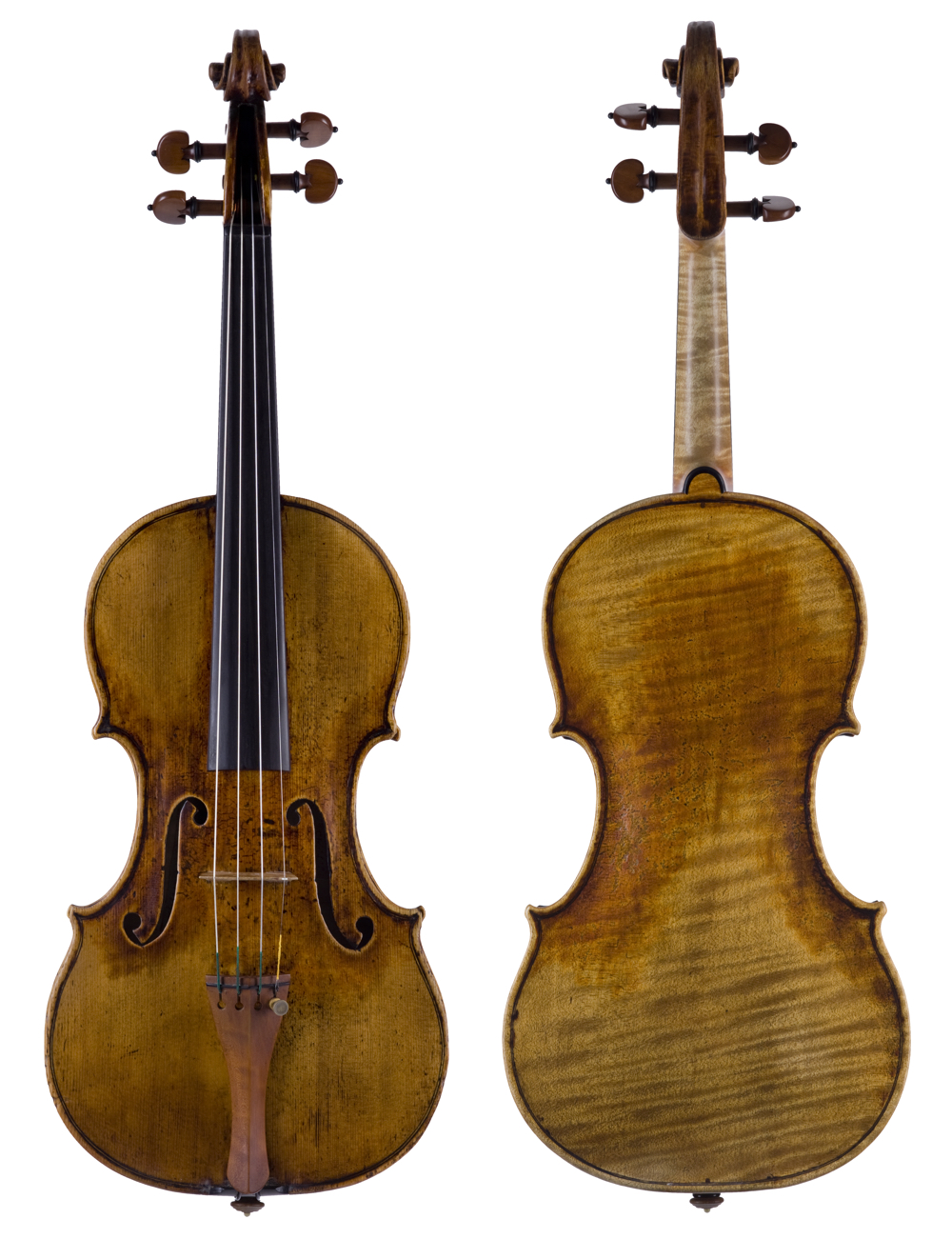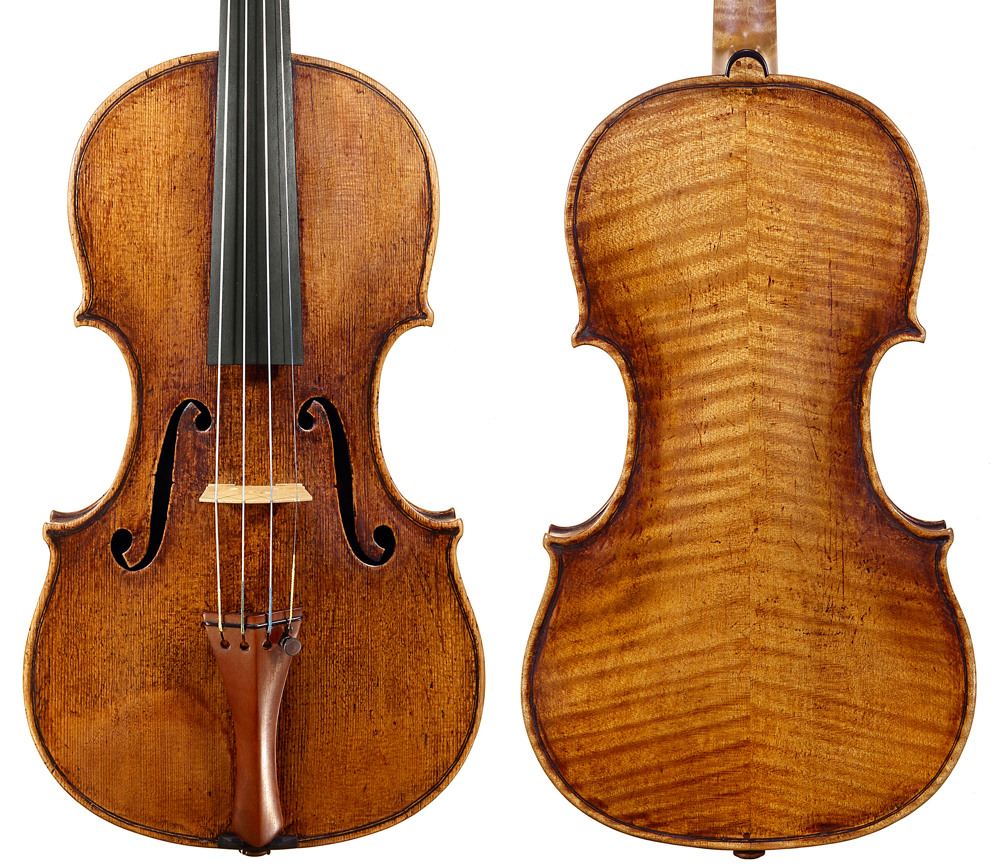
Rachel Barton Pine with her current instrument, the ‘Soldat’ Guarneri ‘del Gesù’ of 1742
My first long-term relationship with any instrument started after I won the gold medal in the Bach Competition in Leipzig in 1992. Prior to that I’d never owned a violin. I was borrowing a modern one for my daily practice and it had enough color that it was suitable for my studies, and wasn’t holding me back in terms of my education, but it didn’t have the projection for concerts and competitions, so whenever I had an important occasion I had to borrow one from a shop.
I’d be lent something two days before a concerto performance, which was stressful: the subtle details – the curve of the bridge, the exact intonation, not to mention the artistic dimension of finding its colors. The flipside is that I had the opportunity to perform on more of a variety of instruments than young people who have something on long-term loan or own their own instrument.
Playing so many instruments in my teenage years was an education and I learnt something from each one. All these voices also enabled me to define my own taste, so by the time I received my first long-term loan when I was 17, I really knew what I liked and what suited my playing.
I was first loaned a 1617 Brothers Amati, the ‘Lobkowitz’, which was bought by a patron as an investment, for my use. I used it for eight years and I made many of my important debuts and inital recordings on it. The sound was big, deep and rich. It was unusual because for 1617 you’d think it would be a smaller, lighter, chamber music instrument. The theory is that it was so early that it was probably from a violin consort – late-Renaissance or early Baroque – where there would be different sizes of instruments, including a small violin and a large viola. From the perspective of such a band this was the second violin – the alto violin – which is why it was a bit bigger and darker.

Barton Pine used the 1617 ‘Lobkowicz’ Brothers Amati for most of her early recordings. Photos courtesy of Bein & Fushi, Inc
I had to use heavy-gauge strings on the Amati because Thomastik-Infeld hadn’t yet invented Visions. I used Dominant Stark strings, which meant a workout for my fingers. When I recorded the pizzicato variation of Paganini’s Le Streghe my fingers actually bled because of those heavy-gauge strings. But the Amati projected, which made it an excellent concerto instrument. It was in good health, and it had the red wax seal of the Lobkowitz family – Beethoven’s patrons – on the back of the neck. I was very attached to it and remain eternally grateful to the amazing generosity of its owner, but I would pick up a ‘del Gesù’ in a shop, and think, ‘I hope to get to play something like this one day.’
A gentleman who was a fan came to me and said, ‘I’ve got a Strad under my bed, which you can use if you want.’
In 2000 a gentleman who was a fan had heard me at a concert and came to me and said, ‘I’ve got a Strad under my bed, which you can use if you want.’ We’ve all heard the Strad-under-the-bed story, but his really was a Strad [the 1684 ‘Lord Elphinstone’]. It had been sitting under his bed for years, although he had loaned it for a time to a soloist. It was an amazing opportunity, but when I got hold of it, it didn’t speak well. I thought that maybe this was one of the Strads with the name but not the voice, and worried about how to tell this gentleman that I didn’t want his Strad after all.
Luckily, my husband pointed out that there must be something to it if it had been played by another soloist, and suggested I get it adjusted and play it for a few days to see if it woke up. It needed a little adjustment, to be vibrated and played in, and then it only took a few days to blossom. It continued to do so in a more subtle way over the next few months. All of a sudden I didn’t want to play my Amati any more – it was amazing how unsentimental I became about it. I had started my new relationship with the Strad and said goodbye to the Amati.
Shortly thereafter I was lent the 1744 ‘Lord Coke’ ‘del Gesù’ for a while and when I switched to it, I expected to play it for many years. However, when I was about to record the Brahms concerto with the Chicago Symphony in 2002, someone I knew, knew the owner of the 1742 ex-Soldat ‘del Gesù’, which had been selected by Brahms himself for one of the first champions of the concerto, Marie Soldat.
It’s interesting that Brahms chose this sound, obviously with Marie Soldat in mind. This instrument can be sweet when it wants, but it is a manly voice. That was characteristic of Marie Soldat – she was a strong and powerful player. A generation ago in competitions, there was still a male European attitude among the jury that the Brahms was a man’s concerto: you could see this in the final rounds. But obviously Brahms didn’t think so because on one side of the ocean Soldat was championing it and on the other side Maud Powell was one of the first champions of the work.
I was lent the 1742 ‘del Gesù’ for the Brahms recording, and as pretty as the 1744 one was, this was love at first sight – everything I ever dreamed of in a violin. It had everything I envisioned and much more that I would never have thought of if it hadn’t been telling me. I thought, ‘I can’t give this back, it would break my heart.’ Luckily the owner was happy with the recording and decided to loan it to me long term, even though that hadn’t been the original plan. I had the awkward moment of having to give back the other one to its owner, and began my new life with the ‘Soldat’. A few years ago the owner decided officially to lend it to me on lifetime loan, so I have that amazing security.
Rachel Barton Pine Foundation
A generation ago, if an artist became successful they could eventually buy their own instrument. Now, no matter how successful you are, unless you do what Hilary Hahn or Christian Tetzlaff have done and forgo a Strad or Guarneri, it doesn’t matter if you have one of the best incomes as a soloist – it’s never going to be enough to allow you to buy your own instrument.

The ‘Soldat’ Guarneri ‘del Gesù’ 1742 – ‘It had everything I envisioned and much more,’ says Barton Pine. Photos: J.B. Spector, Chicago
My foundation has 40 instruments, half of them owned by third parties. We also have instruments and bows gifted to us by makers, inheritors or retirees. For example, we just received a viola by Larry Furse, made in the 1980s. It came from a professional who didn’t need to sell it to fund her retirement and wanted the satisfaction of knowing it was going to be played. It was wonderful timing because we had a teenage violist who had been winning competitions on a $200 viola from eBay. It was junk, and she needed a proper instrument, and this Furse instrument arrived. It was the same month that we got the 1732 ‘Arkwright Lady Rebecca Sylvan’ Stradivari, and in a way I was almost more excited by the viola because I knew it was for someone who needed it immediately.
Bows are an important piece of the puzzle, which many foundations and patrons don’t take seriously enough.
We like to loan instruments for as long as possible: as long as the players need and deserve them. There was one patron in Chicago who was motivated by altruism, but she had a policy of only loaning her instrument out for two years, so many people turned down the offer. She meant well, but two years isn’t long enough to get to a point where you’re able to buy something yourself.
Having seen these things over the years from a player’s perspective, I have a different insight, for example with bows. When I was loaned the 1617 Amati, I was 17, my father was unemployed, my mum was taking care of me and my sisters, and I was still a student. I had a $2,000 bow, which was an excellent playing stick and responded to all my articulations, but it was too light, too simple. I would pick up Sartorys and run them across the strings of the Amati and it would sound like twice the instrument. I didn’t have $10,000 and my patron had no interest in buying a bow, because bows aren’t ‘sexy’. So my foundation has a number of bows and sometimes we’ll lend just a bow to someone who has a violin from elsewhere. It’s an important piece of the puzzle, which many foundations and patrons don’t take seriously enough.
My foundation also pays for all players’ expenses from command performances, and we are considerate about them. Of course we want to keep patrons happy, but we only want to work with patrons who realise that we are on the side of the artist. If the patron wants a player to perform at their dinner party, we’re not going to ask the player to cancel work just so they can play there. That attitude is important in order to be a foundation that has its heart in the right place.
Formerly editor of The Strad magazine, Ariane Todes is now a freelance writer and editor.
